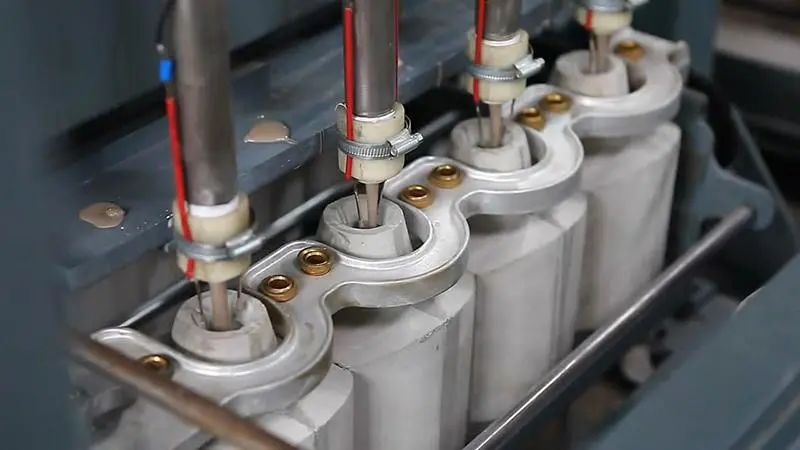Slip casting technology: It provides an effective solution for achieving complex shapes, high precision, and large-scale production.

There is a technology that plays an important role in both the field of traditional ceramics and the field of advanced ceramics. It can be said to be one of the indispensable preparation processes in these two fields, and that is slip casting technology. Slip casting, also known as injection molding or slurry injection molding, is a common ceramic preparation method, which is widely used in the manufacturing process of alumina ceramics.
In the field of traditional ceramics, such as the manufacturing of ceramic tiles, ceramic wares, etc., slip casting technology is widely applied. Traditional ceramics usually use raw materials such as natural clay. The powder is mixed with water or other liquids to form a slurry, which is then injected into a mold for shaping. Slip casting technology can achieve various complex shapes and detailed designs, provide efficient mass production capabilities, and at the same time ensure the consistency of products and the stability of product quality.
Slip casting technology also holds an important position in the preparation of alumina ceramics. Alumina ceramics usually have special performance requirements, such as high-temperature stability, wear resistance, corrosion resistance, etc. In the process of slip casting, the powder of alumina ceramics is preliminarily mixed with an appropriate amount of liquid (usually water or organic solvents) to form a slurry. Then, by controlling the fluidity and viscosity of the slurry, the slurry is injected into a mold or molds to fully fill the cavity of the mold. Subsequently, through subsequent process steps such as solidification and sintering, alumina ceramic products with the required shape and properties are finally obtained. This technology can produce alumina ceramic products with high density and good uniformity, meeting the requirements for material properties and functions in advanced application fields.
The Role of Slip Casting Technology in the Preparation of Alumina Ceramics
① It can be used to prepare alumina ceramic products with complex shapes and details. By adjusting the fluidity of the slurry and the design of the mold, highly precise shape control can be achieved, including holes, thin-walled structures, and microstructures, etc., to meet the requirements for specific shapes in different application fields.
② It can realize the production of alumina ceramic products with high density. Firstly, when the slurry is injected into the mold, it can fully fill the cavity, thus obtaining a higher material density. Secondly, slip casting can also provide a uniform material distribution, reduce the pores and defects in the products, and improve the mechanical properties and reliability of the products.
③ This technology is suitable for mass production and can manufacture a large number of identical or similar products. Moreover, slip casting can also be integrated with automated equipment and processes to achieve the efficient operation of the production line, improving manufacturing efficiency and consistency.
④ Slip casting technology has a wide range of material selection: It can be applied to various advanced ceramic materials, including alumina ceramics, aluminum nitride ceramics, silicon carbide ceramics, etc. This flexibility makes slip casting an important process option in the preparation of alumina ceramics.
Commonly used equipment in the production process of slip casting technology:
① Mixing equipment: It is used to mix ceramic powder and liquid (usually water or other solvents) into a slurry. The mixing equipment can be agitators, mixing tanks, mixing ball mills, etc., which are used to ensure that the powder and liquid are fully and uniformly mixed.
② Slip casting machine: It is used to inject the well-mixed alumina ceramic slurry into the mold for shaping. The slip casting machine usually consists of a slurry storage tank and a slip casting device. The slurry is injected into the mold by means of pressure or vacuum force to achieve the shaping process.
③ Molds: Equipment used for shaping and forming alumina ceramic products. Molds can be made of materials such as metal, plastic, or silicone rubber, and have the required shape and detailed design. During the slip casting process, the slurry is injected into the mold. After the slurry solidifies, the mold is removed, enabling the alumina ceramic product to maintain the required shape.
④ Drying equipment: It is used to dry the formed alumina ceramic products and remove the moisture from them.
⑤ Drying chambers or drying platforms, etc.: Select appropriate drying methods and parameters according to the size and characteristics of the alumina ceramic products.
⑥ Sintering furnace: It is used to sinter the dried alumina ceramic products, enabling them to form a dense structure at high temperatures. The sintering furnace can be a resistance furnace, an atmosphere furnace, a plasma furnace, etc. Select the appropriate sintering method and conditions according to the requirements of the materials and the technological requirements.
In addition to the above-mentioned equipment, other auxiliary equipment and tools may also be required, such as measuring instruments, control systems, mold cleaning equipment, etc., to ensure the accuracy, stability and high efficiency of the production process.

